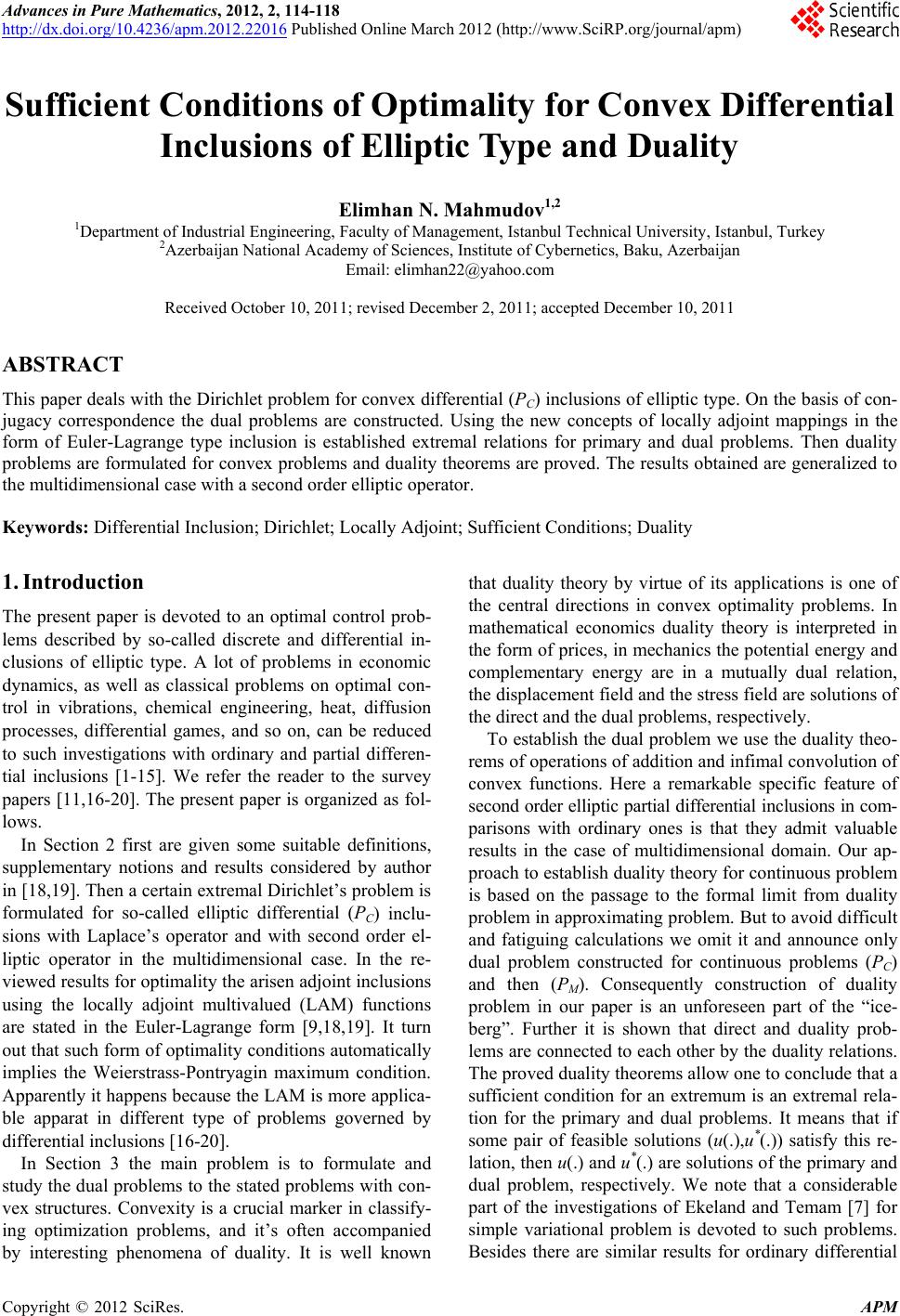 Advances in Pure Mathematics, 2012, 2, 114-118 http://dx.doi.org/10.4236/apm.2012.22016 Published Online March 2012 (http://www.SciRP.org/journal/apm) Sufficient Conditions of Opt im a li ty f or Convex Differential Inclusions of Elliptic Type and Duality Elimhan N. Mahmudov1,2 1Department of Industrial Engineering, Faculty of Management, Istanbul Technical University, Istanbul, Turkey 2Azerbaijan National Academy of Sciences, Institute of Cybernetics, Baku, Azerbaijan Email: elimhan22@yahoo.com Received October 10, 2011; revised December 2, 2011; accepted December 10, 2011 ABSTRACT This paper deals with the Dirichlet problem for convex differential (PC) inclusions of elliptic typ e. On the basis of con- jugacy correspondence the dual problems are constructed. Using the new concepts of locally adjoint mappings in the form of Euler-Lagrange type inclusion is established extremal relations for primary and dual problems. Then duality problems are formulated for convex problems and duality theorems are p roved. The results obtained are gene ralized to the multidimensional case with a second order elliptic operator. Keywords: Differential Inclusion; Dirichlet; Locally Adjoint; Sufficient Conditions; Duality 1. Introduction The present paper is devoted to an optimal control prob- lems described by so-called discrete and differential in- clusions of elliptic type. A lot of problems in economic dynamics, as well as classical problems on optimal con- trol in vibrations, chemical engineering, heat, diffusion processes, differential games, and so on, can be reduced to such investigations with ordinary and partial differen- tial inclusions [1-15]. We refer the reader to the survey papers [11,16-20]. The present paper is organized as fol- lows. In Section 2 first are given some suitable definitions, supplementary notions and results considered by author in [18,19]. Then a certain ex tremal Dirichlet’s problem is formulated for so-called elliptic differential (PC) inclu- sions with Laplace’s operator and with second order el- liptic operator in the multidimensional case. In the re- viewed results for optimality the arisen adjo int inclusions using the locally adjoint multivalued (LAM) functions are stated in the Euler-Lagrange form [9,18,19]. It turn out that such form of optimality conditions automatically implies the Weierstrass-Pontryagin maximum condition. Apparently it happens because the LAM is more applica- ble apparat in different type of problems governed by differential inclusion s [16-20]. In Section 3 the main problem is to formulate and study the dual problems to the stated problems with con- vex structures. Convexity is a crucial marker in classify- ing optimization problems, and it’s often accompanied by interesting phenomena of duality. It is well known that duality theory by virtue of its applications is one of the central directions in convex optimality problems. In mathematical economics duality theory is interpreted in the form of prices, in mechanics the potential energy and complementary energy are in a mutually dual relation, the displacement field and the stress field are solutions of the direct and the dual problems, respectively. To establish the dual problem we use the duality theo- rems of operations of addition and infimal convo lution of convex functions. Here a remarkable specific feature of second order elliptic partial differential inclusions in com- parisons with ordinary ones is that they admit valuable results in the case of multidimensional domain. Our ap- proach to establish duality th eory for continuou s problem is based on the passage to the formal limit from duality problem in approximating problem. But to avo id difficult and fatiguing calculations we omit it and announce only dual problem constructed for continuous problems (PC) and then (PM). Consequently construction of duality problem in our paper is an unforeseen part of the “ice- berg”. Further it is shown that direct and duality prob- lems are connected to each other by the duality relations. The proved duality theo rems allow one to con clude that a sufficient condition for an extremum is an extremal rela- tion for the primary and dual problems. It means that if some pair of feasible solutions (u(.),u*(.)) satisfy this re- lation, then u(.) and u*(.) are solutions of the primary and dual problem, respectively. We note that a considerable part of the investigations of Ekeland and Temam [7] for simple variational problem is devoted to such problems. Besides there are similar results for ordinary differential C opyright © 2012 SciRes. APM 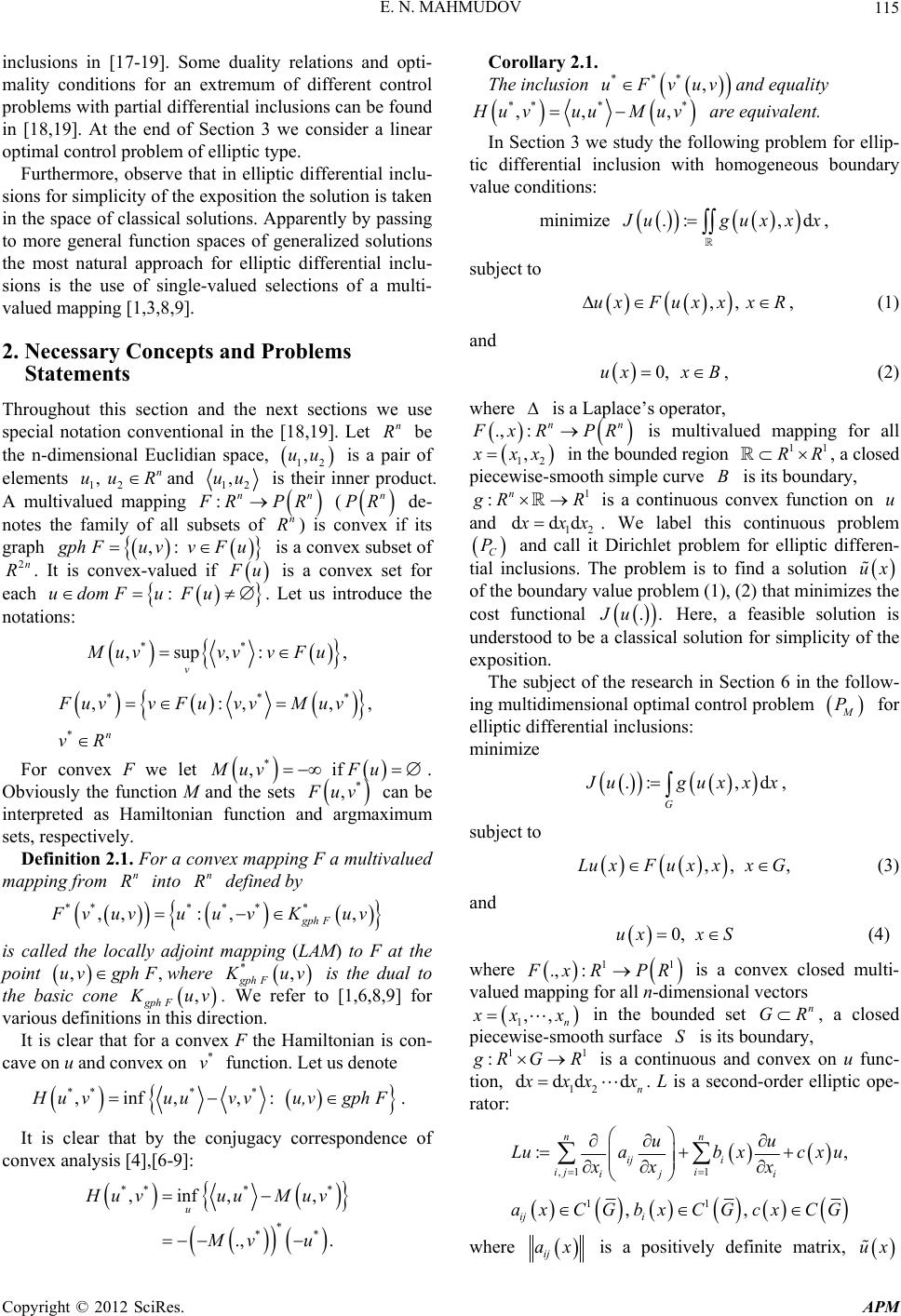 E. N. MAHMUDOV 115 inclusions in [17-19]. Some duality relations and opti- mality conditions for an extremum of different control problems with partial differential inclu sions can be found in [18,19]. At the end of Section 3 we consider a linear optimal control problem of elliptic type. Furthermore, observe that in elliptic differential inclu- sions for simplicity of the exposition the solution is taken in the space of classical solutions. Apparently by passing to more general function spaces of generalized solutions the most natural approach for elliptic differential inclu- sions is the use of single-valued selections of a multi- valued mapping [1,3,8,9]. 2. Necessary Concepts and Problems Statements Throughout this section and the next sections we use special notation conventional in the [18,19]. Let be the n-dimensional Euclidian space, 12 is a pair of elements 12 and n R uu , , n uu R12 ,uu nn is their inner product. A multivalued mapping : RPR ( n PR de- notes the family of all subsets of ) is convex if its graph n R ,: ph FuvvFu is a convex subset of . It is convex-valued if 2n R u is a convex set for each . Let us introduce the notations: : uFuudomF ** ,sup, v: , uvvvvF u * ,,,Muv ** * ,: n Fuvv Fuvv vR For convex F we let if Fu * , * , Muv . Obviously the function M and the sets uv n Rn R * , gph F can be interpreted as Hamiltonian function and argmaximum sets, respectively. Definition 2.1. For a convex mapping F a multivalued mapping from into defined by ** * ,,: , ** vuvuu vK uv uv *, is called the locally adjoint mapping (LAM) to F at the point where gph F , ,gphF uv is the dual to the basic cone , gph F uv . We refer to [1,6,8,9] for various definitions in this direction. It is clear that for a convex F the Hamiltonian is con- cave on u and convex on function. Let us denote * v *** * ,inf,,: uvuuvvu,vgphF . It is clear that by the conjugacy correspondence of convex analysis [4],[6-9]: * * * ** , . ** ,inf, ., u uv uu Mv Muv u Corollary 2.1. *** ,uFvuvand equality The inclusion ** ** ,, , uvuu Muv are equivalent. In Section 3 we study the following problem for ellip- tic differential inclusion with homogeneous boundary value conditions: minimize .:, duguxxx , subject to ,, uxFux xxR , (1) and 0, uxx B , (2) is a Laplace’s operator, where .,: nn xR PR is multivalued mapping for all , 12 xx11 RR B 1 :n in the bounded region , a closed piecewise-smooth simple curve is its boundary, RRu ddd is a continuous convex function on and 12 xx . We label this continuous problem P C and call it Dirichlet problem for elliptic differen- tial inclusions. The problem is to find a solution ux of the boundary v a lu e prob lem (1 ) , (2) th at mini mizes th e cost functional ..Ju Here, a feasible solution is understood to be a classical solution for simplicity of the exposition. The subject of the research in Section 6 in the follow- ing multidimensional optimal control problem M P for elliptic differential inclusions: minimize .:, d G uguxxx , subject to ,, ,Lu xF u xxxG (3) and 0,uxx S (4) where 11 ., : xR PR is a convex closed multi- valued mapping for all n-dimensional vectors ,, 1n xxn GR S 11 : in the bounded set , a closed piecewise-smooth surface is its boundary, RG R 12 dddd n is a continuous and convex on u func- tion, xx x . L is a second-order elliptic ope- rator: ,1 1 :, nn ij i ij i iji uu Luabxcx u xx x 11 ,, ij i ax CGbx CGcxCG ij ax where is a positively definite matrix, ux Copyright © 2012 SciRes. APM 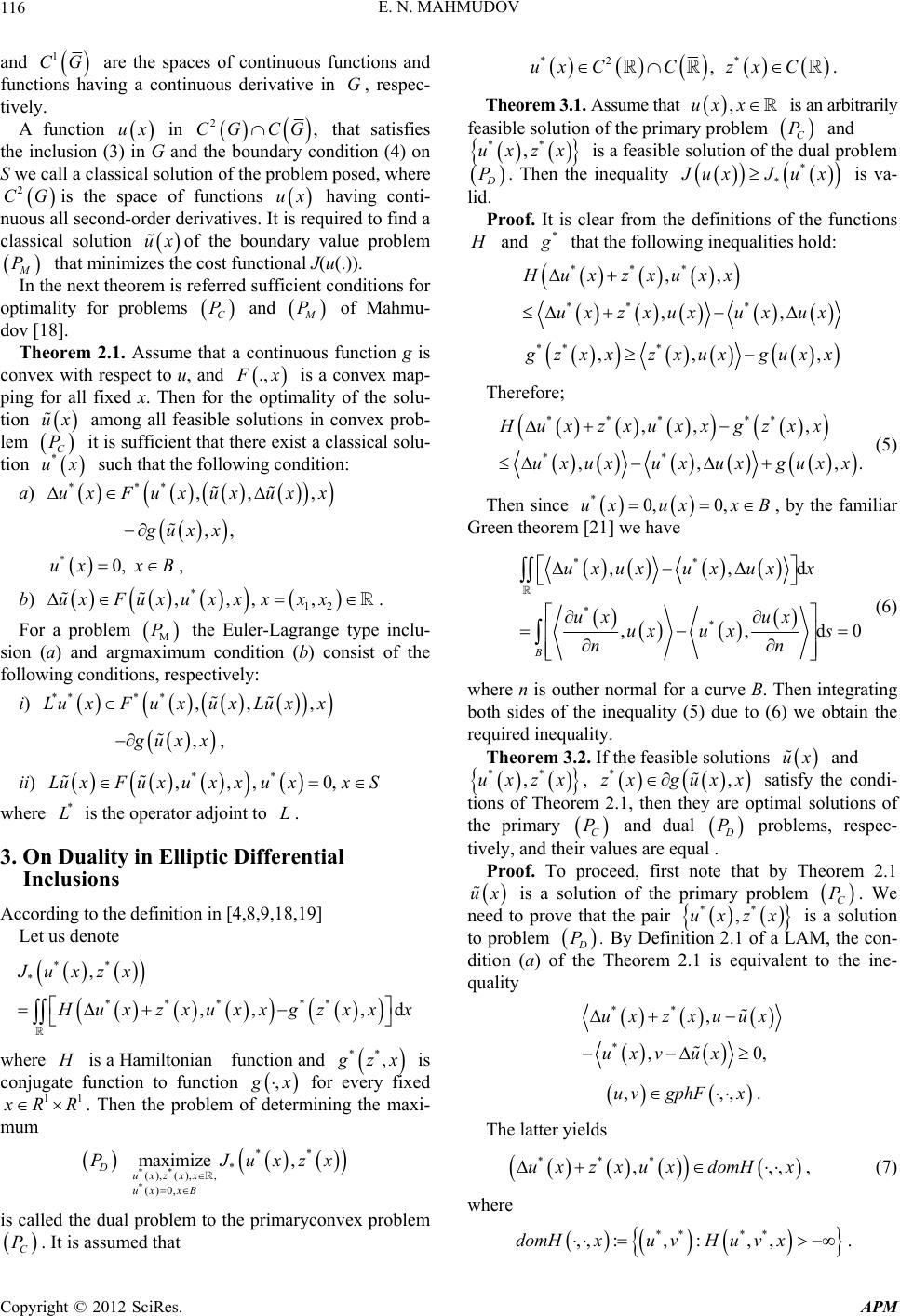 E. N. MAHMUDOV 116 and 1 CG G are the spaces of continuous functions and functions having a continuous derivative in , respec- tively. A function in ux ,CG CG M P 2 ux ., that satisfies the inclusion (3) in G and the boundary condition (4) on S we call a classical solution of the problem posed, where is the space of functions ux having conti- nuous all second-order derivatives. It is required to find a classical solution of the boundary value problem that minimizes the cost functional J(u(.)). 2 CG M P In the next theorem is referred sufficient conditions for optimality for problems and of Mahmu- dov [18]. C P Theorem 2.1. Assume that a continuous function g is convex with respect to u, and x ux C P * ux ,ux x , , is a convex map- ping for all fixed x. Then for the optimality of the solu- tion among all feasible solutions in convex prob- lem it is sufficient that there exist a classical solu- tion such that the following condition: a) * uxx u ** Fu ,,x ux x 0, xB 12 ,xx P ,u xx , * ux , b) . * ,,,uxFux uxx x ,,xL For a problem the Euler-Lagrange type inclu- sion (a) and argmaximum condition (b) consist of the following conditions, respectively: i) *** * Lu xF u xu ux x 0,xxS L L ** ,d , ii) ** ,,,Lu xFu xuxu * x * ,, where is the operator adjoint to . 3. On Duality in Elliptic Differential Inclusions According to the definition in [4,8,9,18,19 ] Let us denote ** * ** ,Jux zx ux zxxg uxzxxx where is a Hamiltonian function and ** , zx is conjugate function to function , x for every fixed 11 RR ** ,uxzx C P . Then the problem of determining the maxi- mum ** * * () , (),, () 0, max i miz e Duxzxx ux xB PJ is called the dual problem to the primaryconvex problem . It is assumed that *2 * , ux CCzx C ,uxx P . Theorem 3.1. Assume that is an arbitrarily feasible solution of the primary problem C and ** ,uxzx is a feasible solution of the du al problem P * * . Then the inequality uxJ ux is va- lid. Proof. It is clear from the definitions of the functions * and that the following inequ a lities hold: *** ** * ,, ,, Huxzxuxx ux zxuxuxux ** * ,, , zxxzxux guxx Therefore; ***** ** ,, , ,, ,. Huxzxuxxgzxx uxuxux uxguxx (5) *0, 0,ux uxxB Then since , by the familiar Green theorem [21] we have ** ** ,,d ,,d0 B uxuxux uxx ux ux uxuxs nn ux (6) where n is outher normal for a curve B. Then integrating both sides of the inequality (5) due to (6) we obtain the required inequality. Theorem 3.2. If the feasible solutions and ** ,uxzx, *,zx guxx satisfy the condi- tions of Theorem 2.1, then they are optimal solutions of the primary P C and dual P problems, respec- tively, and their values are equal . Proof. To proceed, first note that by Theorem 2.1 ux is a solution of the primary problem P ** ,uxzx C. We need to prove that the pair is a solution to problem P. By Definition 2.1 of a LAM, the con- dition (a) of the Theorem 2.1 is equivalent to the ine- quality ** * , ,0, ux zxuux uxv ux ,,,u vgphFx. The latter yields *** ,,,ux zxuxdomHx , (7) where ** ** ,,:,:, ,domHxu vHuvx . Copyright © 2012 SciRes. APM 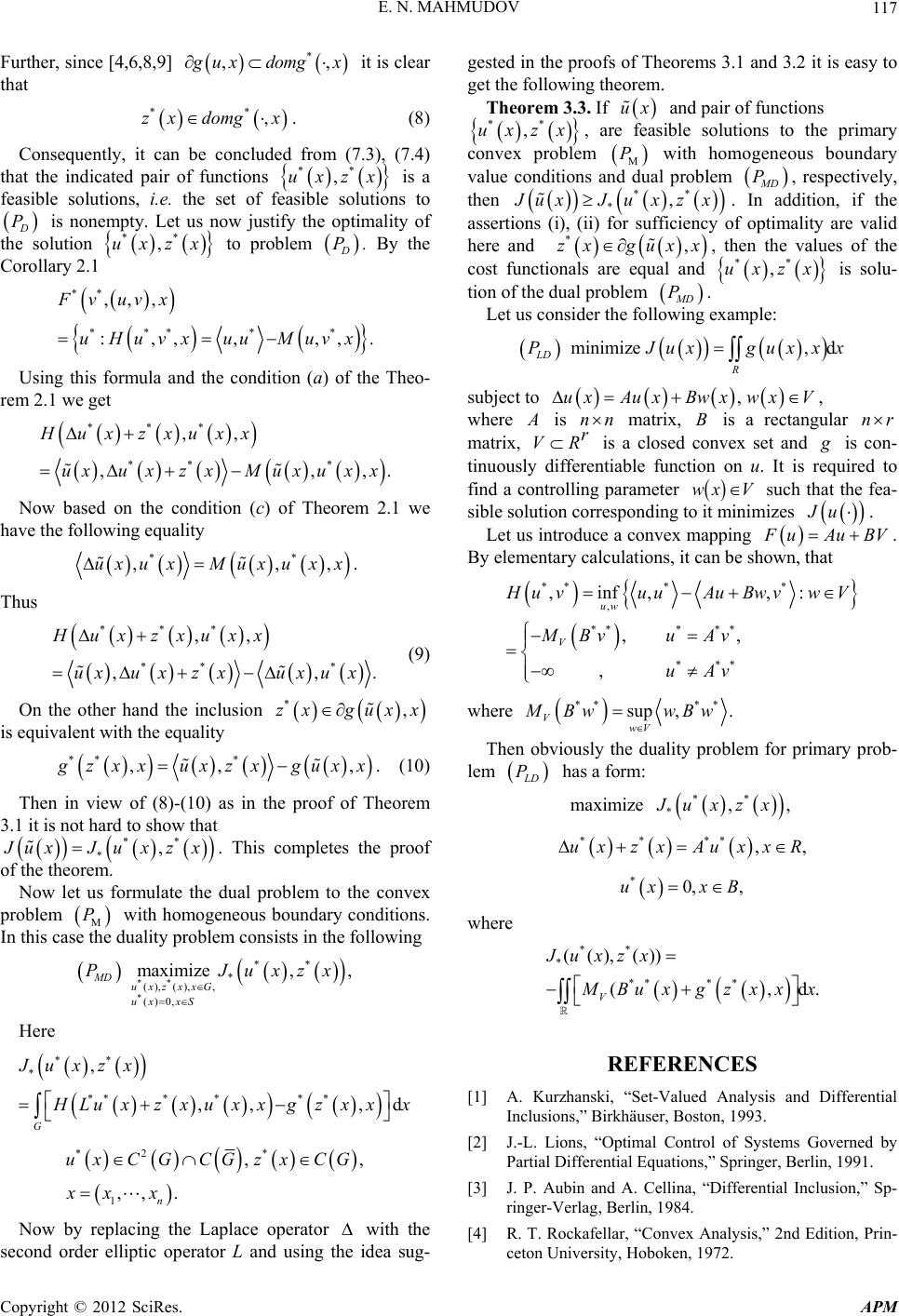 E. N. MAHMUDOV 117 Further, since [4,6,8,9] * ,, u xdomg x ** ,domg x it is clear that zx . (8) Consequently, it can be concluded from (7.3), (7.4) that the indicated pair of functions ** ,uxzx is a feasible solutions, i.e. the set of feasible solutions to P * ,ux is nonempty. Let us now justify the optimality of the solution to problem * zx P. By the Corollary 2.1 ** *** ,,, :,, , Fvuvx uHuvx uu * * ,,.Muvx Using this formula and the condition (a) of the Theo- rem 2.1 we get * , ,.x uxx *** ** ,, , Huxzxuxx uxuxzxMu Now based on the condition (c) of Theorem 2.1 we have the following equ ality ** ,,,xuxx ux uxMu . Thus *** ** ,,Huxzxuxx uxux zx * ,, .uxux (9) On the other hand the inclusion ,guxx * zx is equivalent with the eq uality , ** * ,, zxxuxzxguxx ** , . (10) Then in view of (8)-(10) as in the proof of Theorem 3.1 it is not hard to show that * ux J ux z x P . This completes the proof of the theorem. Now let us formulate the dual problem to the convex problem with homogeneous boundary conditions. In this case the duality problem consists in the following ** , ,uxzx *, ** * * () , (),, ()0, maximiz e MD uxzxxG ux xS PJ Here ** * *** ** , ,, G Juxzx d Luxzxuxx g zxx x *2 1,, . n u xC GCGz xx x * ,,x CG Now by replacing the Laplace operator with the second order elliptic operator L and using the idea sug- gested in the proofs of Theorems 3.1 and 3.2 it is easy to get the following theorem. ux and pair of functio ns Theorem 3.3. If ** ,uxzx, are feasible solutions to the primary convex problem P with homogeneous boundary value conditions and dual problem D, respectively, then P ** , * uxJ ux zx . In addition, if the assertions (i), (ii) for sufficiency of optimality are valid here and *,zx guxx , then the values of the cost functionals are equal and ** ,uxzx is solu- tion of the dual problem D Let us consider the following example: . P minimize, d LD R PJuxguxxx ,uxAuxBwx wxV, subject to nn where is matrix, is a rectangular Bnr matrix, is a closed convex set and r VR is con- tinuously differentiable function on u. It is required to find a controlling parameter such that the fea- sible solution corresponding to it minimizes wx V Ju . Let us introduce a convex mapping uAuBV. By elementary calculations, it can be shown, that ** ** , *** ** *** ,inf, ,: ,, , uw V uvuuAu BwvwV MBvu Av uAv ** ** sup ,. VwV Bw wBw where Then obviously the duality problem for primary prob- lem D P has a form: ** *,, uxzx maximize ** ** ,,ux zxAuxxR *0, ,ux xB ** * *** * ((),()) (,d. V Juxzx where Buxgzxxx REFERENCES [1] A. Kurzhanski, “Set-Valued Analysis and Differential Inclusions,” Birkhäuser, Boston, 1993. [2] J.-L. Lions, “Optimal Control of Systems Governed by Partial Differential Equations,” Springer, Berlin, 1991. [3] J. P. Aubin and A. Cellina, “Differential Inclusion,” Sp- ringer-Verlag, Berlin, 1984. [4] R. T. Rockafellar, “Convex Analysis,” 2nd Edition, Prin- ceton University, Hoboken, 1972. Copyright © 2012 SciRes. APM 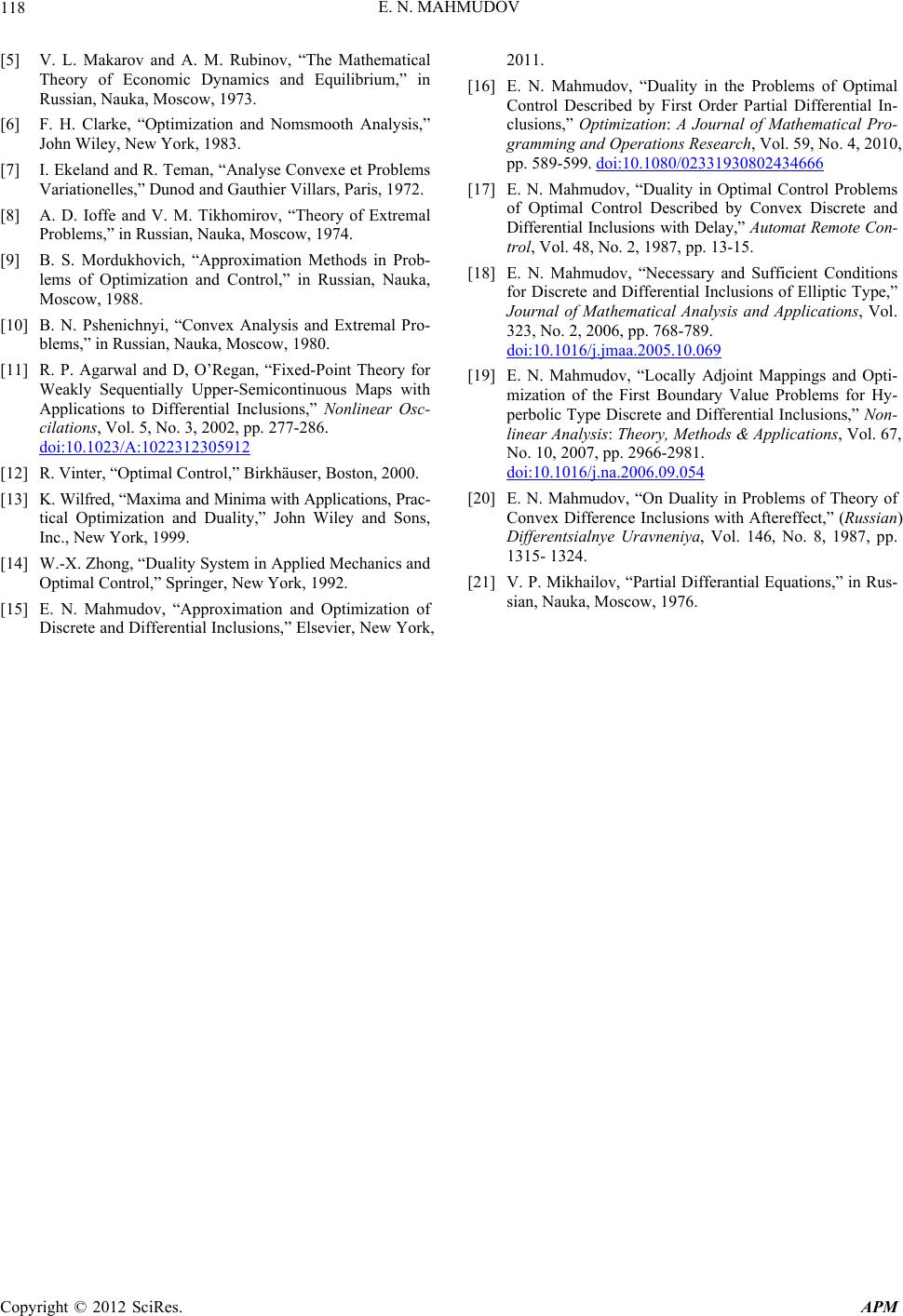 E. N. MAHMUDOV Copyright © 2012 SciRes. APM 118 [5] V. L. Makarov and A. M. Rubinov, “The Mathematical Theory of Economic Dynamics and Equilibrium,” in Russian, Nauka, Moscow, 1973. [6] F. H. Clarke, “Optimization and Nomsmooth Analysis,” John Wiley, New York, 1983. [7] I. Ekeland and R. Teman, “Analyse Convexe et Problems Variationelles,” Dunod and Gauthier Villars, Paris, 1972. [8] A. D. Ioffe and V. M. Tikhomirov, “Theory of Extremal Problems,” in Russian, Nauka, Moscow, 1974. [9] B. S. Mordukhovich, “Approximation Methods in Prob- lems of Optimization and Control,” in Russian, Nauka, Moscow, 1988. [10] B. N. Pshenichnyi, “Convex Analysis and Extremal Pro- blems,” in Russian, Nauka, Moscow, 1980. [11] R. P. Agarwal and D, O’Regan, “Fixed-Point Theory for Weakly Sequentially Upper-Semicontinuous Maps with Applications to Differential Inclusions,” Nonlinear Osc- cilations, Vol. 5, No. 3, 2002, pp. 277-286. doi:10.1023/A:1022312305912 [12] R. Vinter, “Optimal Control,” Birkhäuser, Boston, 2000. [13] K. Wilfred, “Maxima and Minima with Applications, Prac- tical Optimization and Duality,” John Wiley and Sons, Inc., New York, 1999. [14] W.-X. Zhong, “Duality System in Applied Mechanics and Optimal Control,” Springer, New York, 1992. [15] E. N. Mahmudov, “Approximation and Optimization of Discrete and Differential Inclusions,” Elsevier, New York, 2011. [16] E. N. Mahmudov, “Duality in the Problems of Optimal Control Described by First Order Partial Differential In- clusions,” Optimization: A Journal of Mathematical Pro- gramming and Operations Research, Vol. 59, No. 4, 2010, pp. 589-599. doi:10.1080/02331930802434666 [17] E. N. Mahmudov, “Duality in Optimal Control Problems of Optimal Control Described by Convex Discrete and Differential Inclusions with Delay,” Automat Remote Con- trol, Vol. 48, No. 2, 1987, pp. 13-15. [18] E. N. Mahmudov, “Necessary and Sufficient Conditions for Discrete and Differential Inclusions of Elliptic Type,” Journal of Mathematical Analysis and Applications, Vol. 323, No. 2, 2006, pp. 768-789. doi:10.1016/j.jmaa.2005.10.069 [19] E. N. Mahmudov, “Locally Adjoint Mappings and Opti- mization of the First Boundary Value Problems for Hy- perbolic Type Discrete and Differential Inclusions,” Non- linear Analysis: Theory, Methods & Applications, Vol. 67, No. 10, 2007, pp. 2966-2981. doi:10.1016/j.na.2006.09.054 [20] E. N. Mahmudov, “On Duality in Problems of Theory of Convex Difference Inclusions with Aftereffect,” (Russian) Differentsialnye Uravneniya, Vol. 146, No. 8, 1987, pp. 1315- 1324. [21] V. P. Mikhailov, “Partial Differantial Equations,” in Rus- sian, Nauka, Moscow, 1976.
|